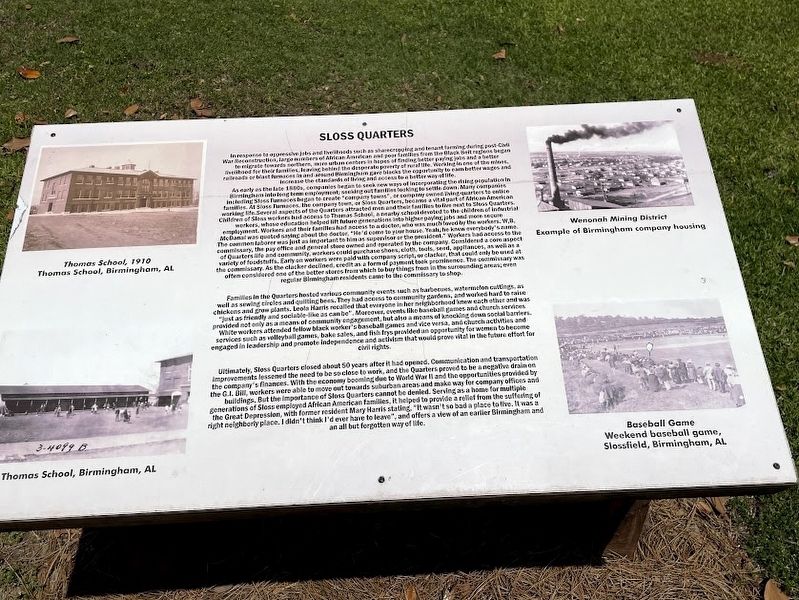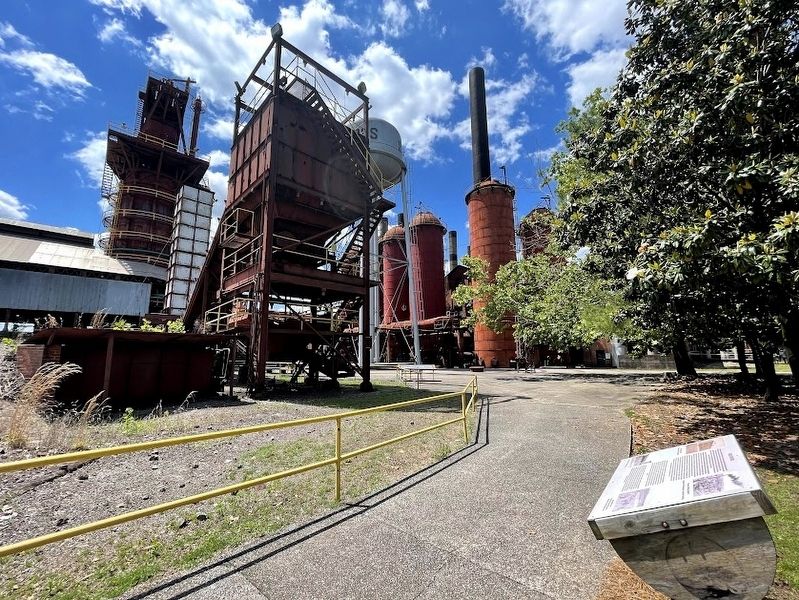Central City in Birmingham in Jefferson County, Alabama — The American South (East South Central)
Sloss Quarters
As early as the late 1880s, companies began to seek new ways of incorporating the rising population in Birmingham into long term employment, seeing out families looking to settle down. Many companies including Sloss Furnaces began to create "company towns", or company owned living quarters to entice families. At Sloss Furnaces, the company town, or Sloss Quarters, became a vital part of African American working life. Several aspects of the Quarters attracted men and their families to live next to Sloss Quarters. Children of Sloss workers had access to Thomas School, a nearby school devoted to the children of industrial workers, whose education helped lift future generations into higher paying jobs and more secure employment. Workers and their families had access to a doctor, who was much loved by the workers. W.B. McDanal was quoted saying about the doctor. "He'd come to your house. Yeah, he knew everybody's name. The common laborer was just as important to him as supervisor or the president." Workers had access to the commissary, the pay office and general store owned and operated by the company. Considered a core aspect of Quarters life and community, workers could purchase shoes, cloth, tools, seed, appliances, as well as a variety of foodstuffs. Early on workers were paid with company script, or clacker, that could only be used at the commissary. As the clacker declined, credit as a form of payment took prominence. The commissary was often considered one of the better stores from which to buy things from in the surrounding areas; even regular Birmingham residents came to the commissary to shop.
Families in the Quarters hosted various community events such as barbecues, watermelon cuttings, as well as sewing circles and quilting bees. They had access to community gardens, and worked hard to raise chickens and grow plants. Leola Harris recalled that everyone in her neighborhood knew each other and was "Just as friendly and sociable-like as can be". Moreover, events like baseball games and church services provided not only as a means of community engagement, but also a means of knocking down social barriers. White workers attended fellow black worker's baseball games and vice versa, and church activities and services such as volleyball games, bake sales, and fish frys provided an opportunity for women to become engaged in leadership and promote independence and activism that would prove vital in the future effort for civil rights.
Ultimately, Sloss Quarters closed about 50 years after it had opened. Communication and transportation improvements lessened the need to be so close to work, and the Quarters proved to be a negative drain on the company's finances. With the economy booming due to World War I and the opportunities provided by the G.I. Bill, workers were able to move out towards suburban areas and make way for company offices and buildings. But the importance of Sloss Quarters cannot be denied. Serving as a home for multiple generations of Sloss employed African American families, it helped to provide a relief from the suffering of the Great Depression, with former resident Mary Harris stating, "It wasn't so bad, a place to live. It was a right neighborly place. I didn't think I'd ever have to leave", and offers a view of an earlier Birmingham and an all but forgotten way of life.
Captions
(top left): Thomas School, 1910 Thomas School, Birmingham, AL
(top right): Wenonah Mining District Example of Birmingham company housing
(bottom right): Baseball Game Weekend baseball game, Slossfield, Birmingham, AL
(bottom left): Thomas School, Birmingham, AL
Topics. This historical marker is listed in these topic lists: African Americans • Industry & Commerce.
Location. 33° 31.268′ N, 86° 47.472′ W. Marker is in Birmingham, Alabama, in Jefferson County. It is in Central City. Marker can be reached from the intersection of 32nd Street South and 1st Avenue N (U.S. 11). The marker is located on the grounds of the Sloss Furnaces National Historic Landmark. Touch for map. Marker is at or near this postal address: 20 32nd Street S, Birmingham AL 35222, United States of America. Touch for directions.
Other nearby markers. At least 8 other markers are within walking distance of this marker. Ironmaking (within shouting distance of this marker); Slag (within shouting distance of this marker); The Gas System (within shouting distance of this marker); The Blast Furnace (within shouting distance of this marker); Casting Pigs (within shouting distance of this marker); The Stock Trestle (within shouting distance of this marker); Racial Terrorism and Convict Leasing / Racial Violence at Brookside Mines (within shouting distance of this marker); The Blowing Engine Room (within shouting distance of this marker). Touch for a list and map of all markers in Birmingham.
Credits. This page was last revised on April 22, 2023. It was originally submitted on April 18, 2023, by Darren Jefferson Clay of Duluth, Georgia. This page has been viewed 107 times since then and 28 times this year. Photos: 1, 2. submitted on April 18, 2023, by Darren Jefferson Clay of Duluth, Georgia. • James Hulse was the editor who published this page.

